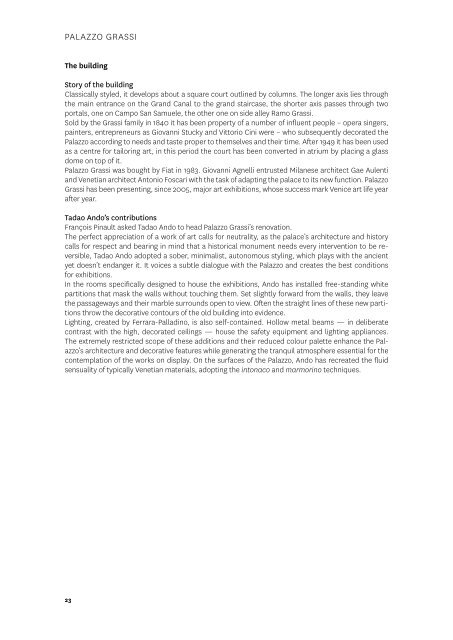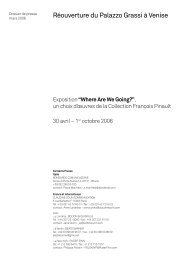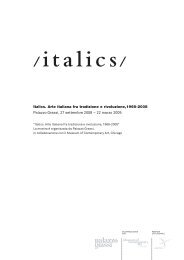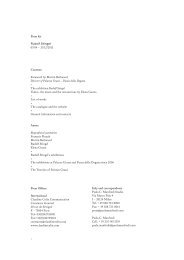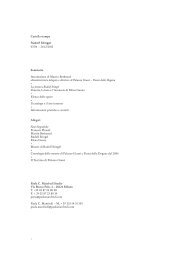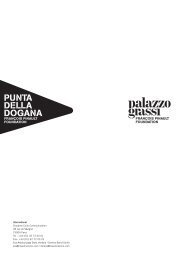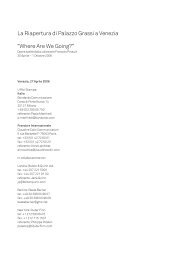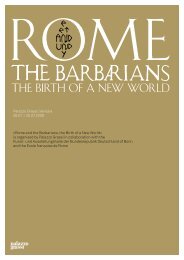Press Kit (pdf file - 445,85 Kb) - Palazzo Grassi
Press Kit (pdf file - 445,85 Kb) - Palazzo Grassi
Press Kit (pdf file - 445,85 Kb) - Palazzo Grassi
Create successful ePaper yourself
Turn your PDF publications into a flip-book with our unique Google optimized e-Paper software.
PALAZZO GRASSI<br />
The building<br />
Story of the building<br />
Classically styled, it develops about a square court outlined by columns. The longer axis lies through<br />
the main entrance on the Grand Canal to the grand staircase, the shorter axis passes through two<br />
portals, one on Campo San Samuele, the other one on side alley Ramo <strong>Grassi</strong>.<br />
Sold by the <strong>Grassi</strong> family in 1840 it has been property of a number of influent people – opera singers,<br />
painters, entrepreneurs as Giovanni Stucky and Vittorio Cini were – who subsequently decorated the<br />
<strong>Palazzo</strong> according to needs and taste proper to themselves and their time. After 1949 it has been used<br />
as a centre for tailoring art, in this period the court has been converted in atrium by placing a glass<br />
dome on top of it.<br />
<strong>Palazzo</strong> <strong>Grassi</strong> was bought by Fiat in 1983. Giovanni Agnelli entrusted Milanese architect Gae Aulenti<br />
and Venetian architect Antonio Foscari with the task of adapting the palace to its new function. <strong>Palazzo</strong><br />
<strong>Grassi</strong> has been presenting, since 2005, major art exhibitions, whose success mark Venice art life year<br />
after year.<br />
Tadao Ando’s contributions<br />
François Pinault asked Tadao Ando to head <strong>Palazzo</strong> <strong>Grassi</strong>’s renovation.<br />
The perfect appreciation of a work of art calls for neutrality, as the palace’s architecture and history<br />
calls for respect and bearing in mind that a historical monument needs every intervention to be reversible,<br />
Tadao Ando adopted a sober, minimalist, autonomous styling, which plays with the ancient<br />
yet doesn’t endanger it. It voices a subtle dialogue with the <strong>Palazzo</strong> and creates the best conditions<br />
for exhibitions.<br />
In the rooms specifically designed to house the exhibitions, Ando has installed free-standing white<br />
partitions that mask the walls without touching them. Set slightly forward from the walls, they leave<br />
the passageways and their marble surrounds open to view. Often the straight lines of these new partitions<br />
throw the decorative contours of the old building into evidence.<br />
Lighting, created by Ferrara-Palladino, is also self-contained. Hollow metal beams — in deliberate<br />
contrast with the high, decorated ceilings — house the safety equipment and lighting appliances.<br />
The extremely restricted scope of these additions and their reduced colour palette enhance the <strong>Palazzo</strong>’s<br />
architecture and decorative features while generating the tranquil atmosphere essential for the<br />
contemplation of the works on display. On the surfaces of the <strong>Palazzo</strong>, Ando has recreated the fluid<br />
sensuality of typically Venetian materials, adopting the intonaco and marmorino techniques.<br />
23


